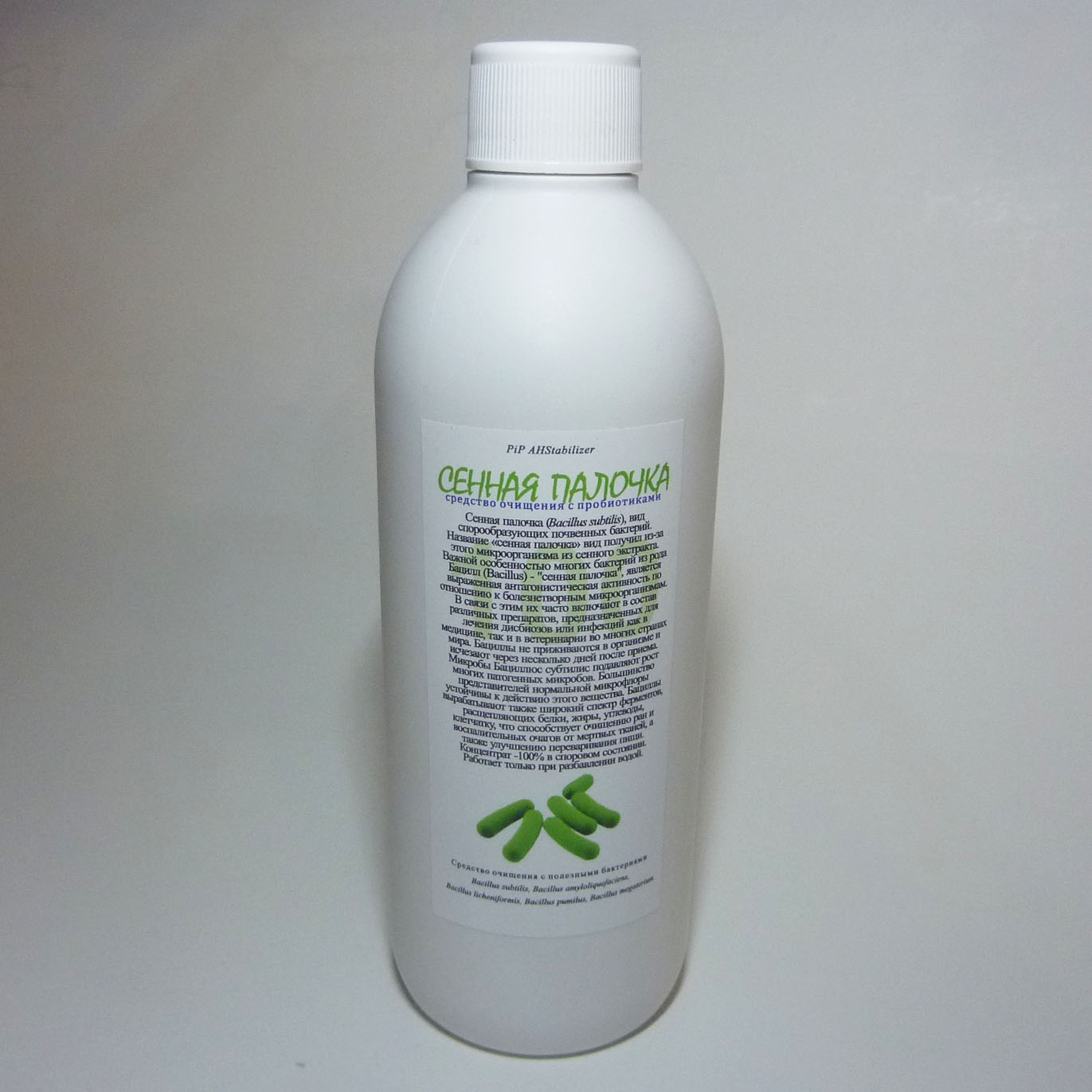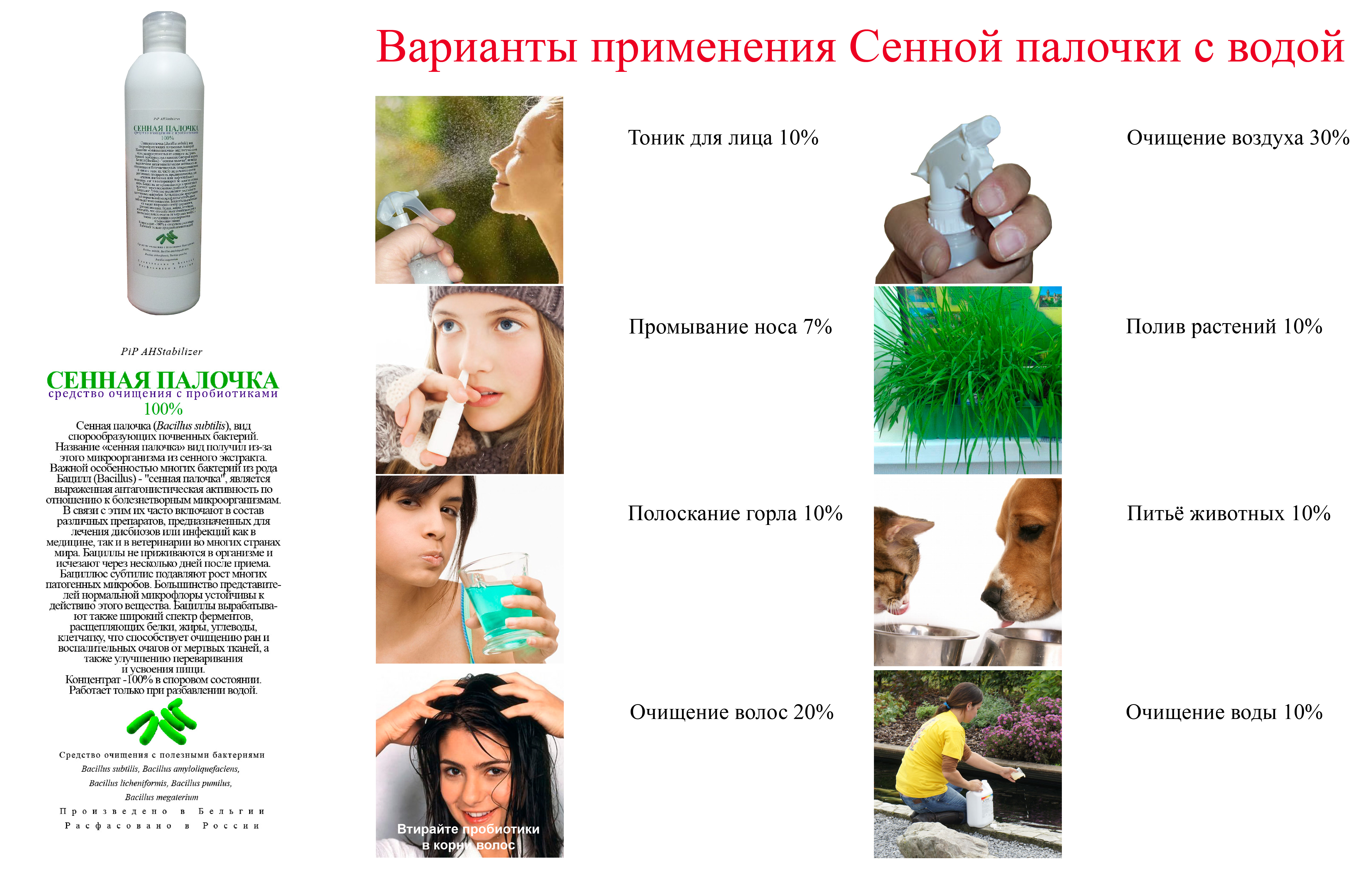СЕННАЯ ПАЛОЧКА
Бациллы против бактерий. Атакуют и побеждают
Сенна́я па́лочка (лат. Bacillus subtilis) — вид грамположительнх
спорообразующих факультативно аэробных[1]
почвенных бактерий. Первоначально были описаны в 1835 Эренбергом как Vibrio subtilis, в 1872 были переименованы Коном в Bacillus subtilis. Название «сенная палочка» вид получил из-за того, что накопительные культуры этого микроорганизма получают из сенного экстракта.

Важной особенностью многих бактерий из рода Бацилл (Bacillus) - "сенная палочка", является выраженная антагонистическая активность по отношению к болезнетворным микроорганизмам. В связи с этим их часто включают в состав различных препаратов, предназначенных для лечения дисбиозов или инфекций как в медицине, так и в ветеринарии во многих странах мира от Китая до США, включая Европу. Чаще всего в составе подобных препаратов используется Бациллюс субтилис (Bacillus subtilis). Следует обратить внимание на тот факт, что бациллы не приживаются в нашем организме и исчезают через несколько дней после прекращения приема препарата.
Перечень показаний к использованию препаратов, содержащих бациллы, очень широк: от лечения острых кишечных инфекций до профилактики гнойных инфекций после хирургических препаратов. Не менее широк перечень возможных способов их применения.

Бациллюс субтилис способны к продукции антибактериального вещества широкого спектра действия, подавляющего развитие многих патогенных и условно-патогенных бактерий. Особо следует отметить, что большинство представителей нормальной микрофлоры устойчивы к действию этого вещества. Бациллы вырабатывают также широкий спектр ферментов, расщепляющих белки, жиры, углеводы, клетчатку, что способствует очищению ран и воспалительных очагов от мертвых тканей, а также улучшению переваривания и усвоения пищи.
ОТЧЁТ-СЕРТИФИКАТ об испытаниях "сенной палочки".
Report certification of Bacillus species
Bacillus subtilis According to the ATCC database, all Bacillus subtilis strains have a biosafety level of 1. All of them can be used as a transformation host. Some other application are:
• Transformation and screening of gene mutant libraries (47096)
• Plasmid transformation host (31785, 33677)
• Intermediate host in host-vector system (39091, 39092)
• Certified HV1 host strain (31578)
• Plasmid host strain with a high transformation frequency (33625)
• Amylase-negative parent strain in host-vector system (39085, 39096)
• Amylase-negative intermediate host in host-vector system (39093)
• asporogenous host (39094, 39095, 39096)
• DNA donor in host-vector system (39086, 39087, 39090) This material is cited in a U.S. and/or other Patent or Patent Application, and may not be used to infringe on the patent claims.
Patent: 31785, 39091, 31578, 39085, 39086, 39087, 39092, 39088, 39090, 39093, 39094, 39095, 39096
Bacillus subtilis var. amyloliquefaciens According to the ATCC database, the Bacillus amyloliquefaciens strains have a biosafety level of 1. Some applications are:
• Bacteriophage host (15841)
• amylase (15841, 23842, 23844, 23845)
• Endonuclease BamFI (23350)
• Restriction endonuclease BamN (23845)
• Restriction endonuclease BamNI (23845)
• Restriction endonuclease BamHI (49763, 53495)
• Restriction endonuclease BbvI (9999)
• DNA modification methylase BamHI (53495)
• Ribonuclease (23842, 23844, 23845)
• Protease (23842, 23844, 23845)
• Isoprene (23842)
• Donor of alpha-amylase gene (31592)
• Gramicidin S synthetase (9999)
• Biological control of tan spot of wheat (BAA-390)
• Biological control of Fusarium head blight of wheat (BAA-390)
Patent: 31592, 53495
Bacillus licheniformis According to the ATCC database, the Bacillus licheniformis strains have a biosafety level of 1. Some applications are:
• Alkaline, detergent-resistant protease (21415, 21416, 21417, 21418)
• Alkaline protease (21415, 21416, 21417, 21418, 21424)
• Bacitracin (10716, 11945, 11946)
• Bacteriophage host (12139)
• Production of pentosanases used in removal of pentosan gum from wheat flour (12713)
• Pentosanases (12713)
• Quality control strain (12759)
• Identification of group A streptococci (13438)
• Chitinase and chitobiase activity (14580)
• Inosine (21037, 21038, 21039)
• Inosinic acid (21037, 21038, 21039)
• Proticine (21551)
• Citric acid (21610)
Patent: 21415
Bacillus pumilus
According to the ATCC database, all Bacillus subtilis strains have a biosafety level of 1. All of them can be used as a transformation host. Some other application are:
• SAICAR (5-amino-4-imidazole-n-succinocarboxamide ribonucleotide) (15477)
• Inosine (19164, 21005, 21006, 21007, 21008)
• Inosinic acid (19164)
• Xanthylic acid (19182)
• 5’-guanilic acid (19219, 19220)
• Guanosine (19219, 19220)
• A component of Clostridium thermocellum; symbiont with Bacillus cereus subsp. Mycoides ATCC 19647 in the fermentation of cellulose at 65C (19646)
• 3-amino-3-deoxy-D-glucose (21143)
• D-ribose (21356)
Patent: 15477, 19164, 19182, 19217, 19219, 19220, 19546, 19547, 19548, 21005, 21006, 21007, 21008, 21143, 21356,
Bacillus megaterium
According to the ATCC database, all Bacillus subtilis strains have a biosafety level of 1. All of them can be used as a transformation host. Some other application are:
• Transformation host (35985)
• Lipase active at pH 7.5, not at 5.5 (10778)
• Riboflavin (10778)
• Vitamin B12 (10778, 13639)
• Lysogenic (M1: 11561., 11562, M2: 11561b, M3: 11561c, M4: 11561d, M5: 11561e)
• Restriction endonuclease Bme8991 (11562)
• L-glutamate (13062, 13402)
• Introduction of 15-beta-hydroxyl groups into steroids such as compound S (13368)
• Preparation of protoplasts with lysozyme (13632)
• Penicillin amidase (14945)
• Xanthosine (15046)
Patent: 13062, 13368, 13402, 14945, 14946, 15046
Toxicity tests
Eisenia foetida
Test:
Toxicity tests for earthworms are described in ISO 11268-1 (acute), ISO 11268-1 (reproduction) and ISO11268 (field). The acute toxicity method described is based on placing adult earthworms in a defined substrate containing the test substance in different concentrations and determining the percent mortality after 7 d and 14 d. It does not take into account the possible degradation of the test substance. Price to buy the method from ISO: 48.00 euro.
Toxicity:
No reports of toxicity of any of the mentioned Bacillus strains towards Eisenia foetida is made.
Remarks:
• The growth of Bacillus megaterium in presence of Eisenia foetida and Pheretima guiillelmi is higher than without the worms (1) and also the phosphate turnover in soils are enhanced with these combinations.
• The pigment-free eluate of coelomic fluid of the earthworm (ECFPE) and fetidins (haemolytic and antimicrobial glycoproteins in the coelomic fluid of the earthworm) showed activity against B. megaterium (2,3).
Dapnia magna
Test:
Acute toxicity tests of substances towards Daphnia magna Straus are described in ISO 6341 (1996). Price to buy the method from ISO: 64.00 euro. The test is based on LC50 (lethal concentration: 50% mortality) after 48 hours. These method is already used for the determination of the toxicity of several antibiotics (4).
Toxicity:
No reports of toxicity of any of the mentioned Bacillus strains towards Eisenia foetida is made.
Remarks:
• Daphnia magna, Daphnia hyaline and Simocephalus vetulus fed with Bacillus subtilis show a lower body size, a lower number and size of laid eggs and a shorter postembryonic period duration (5).
Lemna minor
Test:
The ISO standard ISO/CD 20079 describes the method for toxicity tests on Lemna minor. Price to buy the method from ISO: 102.00 euro.
Toxicity:
No examples of toxicity of the Bacillus species towards Lemna minor are reported.
Remarks:
None.
Rats
Test:
Methods for this test are described in ISO 10993-11. Price to buy the method from ISO: 56.00 euro.
Toxicity:
No examples of toxicity of the Bacillus species towards rats are reported.
Remarks:
None.
Oncorhynchus mykiss (rainbow trout)
Test:
Methods for this test are described in ISO 10229:1994. Price to buy the protocol from ISO: 72 euro.
Toxicity:
No reports of acute toxicity towards Oncorhynchus mykiss has been made.
Remarks:
• Bacillus megaterium is a cellulose-degrading bacterium in the fish gut of tilapia (Oreochromis mossambica (Peters)) and the grass carp (Ctenopharyngodon idella (Valenciennes)) (6).
• Bacillus pimulus is an inhabitant of the Indian major carp (Labio rohita) (7).
• Bacillus subtilis was used in a study to assess the possible modulation of seabream (Sparus aurata L.) cellular innate immune parameters to determine any effect due to their possible interaction in the gut microenvironment. In the second week of feeding the head-kidney leucocytes from specimens fed supplemented diet showed a significantly greater phagocytic ability with respect to that of control specimens. The addition of both Lactobacillus delbreuckii and Bacillus subtilis to the fish diet for 3 weeks resulted in a statistically significant increment of the cytotoxic activity of the specimens compared to the values obtained from fish in the control group (8).
• B. subtilis possesses antibiotic activity against pathogenic Vibrio spp. and effectively improves pond water quality and the survival of the black tiger shrimp (9).
• It is also shown that normal trout feed supplemented with spores of Bacillus subtilis and B. licheniformis (BioPlus2B) may be a method to improve resistance in fish against infection with Y. ruckeri in Onchorhyncus mykiss (10).
Terrestrial plants
Test:
Toxicity tests on lettuce can be performed using the ISO 16712:2005 protocol (Soil quality -- Determination of the effects of pollutants on soil flora -- Screening test for emergence of lettuce seedlings (Lactuca sativa L.)’). Price to buy the protocol from ISO: 56.00 euro. The test is based on seed germination, elongation of roots and change in root weight.
Toxicity:
No reports of acute toxicity towards Oncorhynchus mykiss has been made.
Remarks:
• Bacillus subtilis is able to produce cytokinins and to influence the growth and endogenous hormone content of lettuce plants (11). Accumulation of zeatin and its riboside was greatest in roots shortly 2 days after inoculation, when their content was 10 times higher than in control. Changes in the content of other hormones (ABA and IAA) were observed at the end of experiments. Accumulation of cytokinins in inoculated lettuce plants was associated with an increase in plant shoot and root weight of approximately 30% over 8 days.
• The strain B. subtilis CE1 could be a potential biological control agent against F. verticillioides at the root level and thus lower the fumosin production on corn (12).
References
1. Wan, J. H. C. & Wong, M. H. (2004) Effects of earthworm activity and P-solubilizing bacteria on P availability in soil. Journal of Plant Nutrition and Soil Science-Zeitschrift Fur Pflanzenernahrung Und Bodenkunde 167: 209-213.
2. Pan, W. D., Liu, X. G., Ge, F. & Zheng, T. (2003) Reconfirmation of antimicrobial activity in the coelomic fluid of the earthworm Eisenia fetida andrei by colorimetric assay. Journal of Biosciences 28: 723-731.
3. Lassegues, M., Milochau, A., Doignon, F., DuPasquier, L. & Valembois, P. (1997) Sequence and expression of an Eisenia-fetida-derived cDNA clone that encodes the 40-kDa fetidin antibacterial protein. European Journal of Biochemistry 246: 756-762.
4. Wollenberger, L., Halling-Sorensen, B. & Kusk, K. O. (2000) Acute and chronic toxicity of veterinary antibiotics to Daphnia magna. Chemosphere 40: 723-730.
5. Czeczuga, B., Kozlowska, M. & Kiziewicz, B. (2003) Effect of various types of phytoplankton on fertility, egg size and duration of postembryonic growth of a few plankton representatives of Cladocera (Crustacea). Polish Journal of Environmental Studies 12: 545-555.
6. Saha, S., Roy, R. N., Sen, S. K. & Ray, A. K. (2006) Characterization of cellulase-producing bacteria from the digestive tract of tilapia, Oreochromis mossambica (Peters) and grass carp, Ctenopharyngodon idella (Valenciennes). Aquaculture Research 37: 380-388.
7. Ghosh, K., Sen, S. K. & Ray, A. K. (2002) Characterization of Bacilli isolated from the gut of rohu, Labeo rohita, fingerlings and its significance in digestion. Journal of Applied Aquaculture 12: 33-42.
8. Salinas, I., Cuesta, A., Esteban, M. A. & Meseguer, J. (2005) Dietary administration of Lactobacillus delbrueckii and Bacillus subtilis, single or combined, on gilthead seabream cellular innate immune responses. Fish & Shellfish Immunology 19: 67-77.
9. Vaseeharan, B. & Ramasamy, P. (2003) Control of pathogenic Vibrio spp. by Bacillus subtilis BT23, a possible probiotic treatment for black tiger shrimp Penaeus monodon. Letters in Applied Microbiology 36: 83-87.
10. Raida, M. K., Larsen, J. L., Nielsen, M. E. & Buchmann, K. (2003) Enhanced resistance of rainbow trout, Oncorhynchus mykiss (Walbaum), against Yersinia ruckeri challenge following oral administration of Bacillus subtilis and B-licheniformis (BioPlus2B). Journal of Fish Diseases 26: 495-498.
11. Arkhipova, T. N., Veselov, S. U., Melentiev, A. I., Martynenko, E. V. & Kudoyarova, G. R. (2005) Ability of bacterium Bacillus subtilis to produce cytokinins and to influence the growth and endogenous hormone content of lettuce plants. Plant and Soil 272: 201-209.
12. Cavaglieri, L., Orlando, J., Rodriguez, M. I., Chulze, S. & Etcheverry, M. (2005) Biocontrol of Bacillus subtilis against Fusarium verticillioides in vitro and at the maize root level. Research in Microbiology 156: 748-754.
ПРОИЗВОДСТВО.
ФЕРМЕНТАЦИЯ МИКРООРГАНИЗМОВ НА ЗАВОДЕ.
